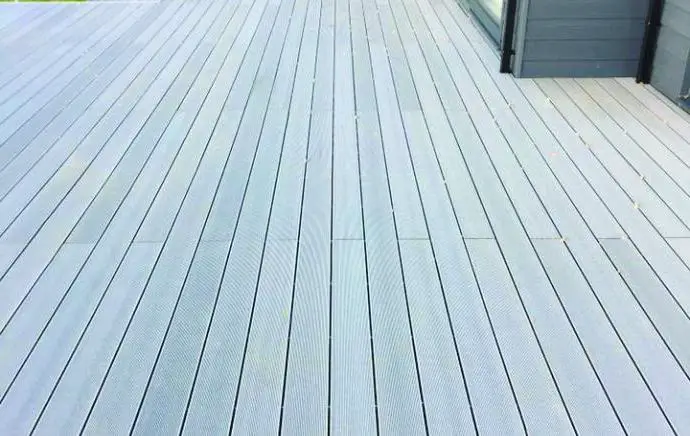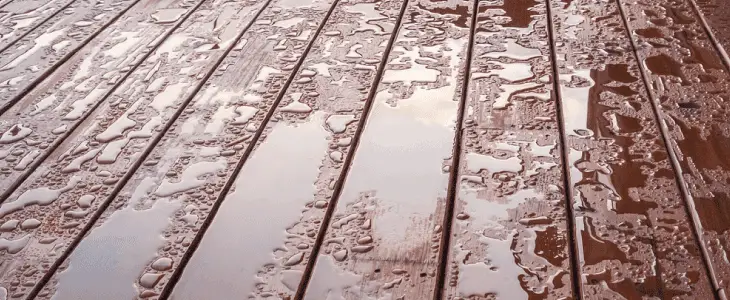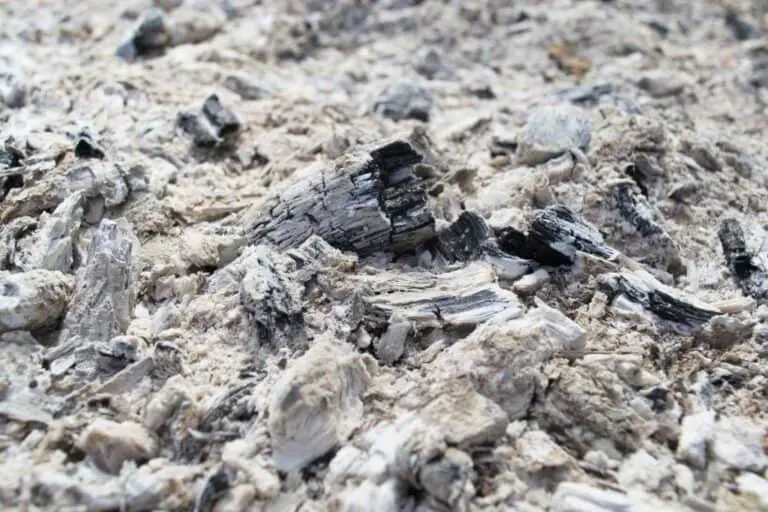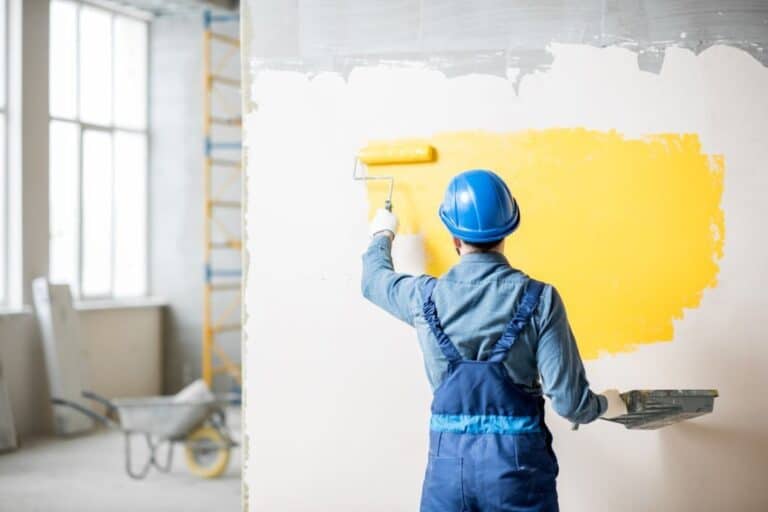How to Restore Faded Composite Decking? (Repair Color Look New Again)

Composite decking is a popular choice for homeowners looking to build decks in their backyard. Composite decking is made from plastic, resin, and wood fibers. Many prefer this type of material for their decks and porches because it is durable, affordable, and easy to maintain.
Although composite decking is said to be resistant to fading, this does not mean it won’t fade. Like any other material, it will fade with time. Composite decking can fade and lose its color quickly if not treated properly.
The good news is that you can repair and regain the color of a fading deck. There are a few easy steps you can take to restore it. By following the steps in this article, your faded composite decking may find its glory again.
What is Composite Decking (Benefits & Drawbacks)?
Composite decking’s material is composed of two or more different materials. The most common type of composite decking is made from wood and plastic. This type of composite decking is made up of sawdust and plastic pellets. The sawdust and plastic pellets are mixed and then heated until they form a solid material.
Composite decking is a modern and innovative material that has become increasingly popular in recent years. It is made from a blend of recycled materials, including wood fibers and plastic, which provide numerous advantages and some disadvantages. Here is a list of the most notable advantages and disadvantages of composite decking.
Advantages of Composite Decking:
- Durability – Composite decking is highly durable and can withstand harsh weather conditions and heavy foot traffic without showing signs of wear and tear.
- Low maintenance – Unlike traditional wood decking, composite decking does not require frequent sealing, staining, or repainting. All that is needed is occasional cleaning with soap and water, making it a low-maintenance option.
- Eco-friendliness – Many manufacturers use recycled materials to create their composite decking products, reducing the amount of waste that ends up in landfills. Additionally, composite decking does not require the use of harmful chemicals or preservatives, which can be harmful to the environment.
- Versatility – Composite decking comes in a variety of colors and styles, allowing homeowners to customize their outdoor living spaces to their liking. Additionally, composite decking can be used for a variety of applications, including decking, railing, and fencing.
- Safety – Non-slip composite decking provides added traction and reduces the risk of slips and falls, making it an ideal choice for families with children or seniors.
Disadvantages of Composite Decking:
- Cost – Composite decking has a higher upfront cost than traditional wood decking.
- Heat retention – Composite decking can retain heat, making it uncomfortable to walk on during hot summer days.
- Susceptible to scratches – Composite decking can be scratched by heavy furniture or sharp objects.
- Color fading – While composite decking comes in a variety of colors, some colors may fade over time, especially in areas with high sun exposure.
- Slippery when wet – While non-slip composite decking provides added traction, it can still be slippery when wet, so caution is advised.
When is Composite Decking Starting to Fade?
Composite decking doesn’t require much maintenance and can last for many years. However, it can start to fade over time, which can make your deck look old and dated.
Some composite decks will fade to a lighter color 12–16 weeks after installation. When they fade, the surface is not in tip-top condition.
They are prone to mold and mildew if specific climatic conditions exist. Mold and mildew may change the appearance and color of the deck, even after the cleaning.
Why Does Composite Decking Fade?
Composite decking manufacturers market their products as low-maintenance. Low maintenance also means that it’s everlasting, no need to take care of it.
But that doesn’t mean it will last forever. Composite decking, however, can fade over time. Sunlight’s UV rays, the environment, and being close to trees or other plants are just a few causes of composite decking fade.
If you’re considering composite decking for your home, it’s important to be aware of the potential for fading and take steps to minimize this risk.
Below are several reasons why composite decking can fade over time.
1. Exposure to Heat of Sunlight
Any material you install in a hot climate and expose to the heat of the sun will degrade and fade. Even though composite decking is more heat-resistant than traditional decking materials, it will eventually also fade. It can take up to 15 years for composite decking to lose its color.
The good news is that decking composites only fade to a lighter gray color when exposed to sunlight. Wood, on the other hand, can become gray or even dark after prolonged exposure to the sun.
2. Growing Mold and Mildew
Mold and mildew can be a huge problem when it comes to maintaining composite decking. These fungi can cause the decking to rot. In order to keep your deck looking great, you need to prevent mold and mildew from growing.
One of the best ways to prevent mold and mildew is by using a sealant. A sealant will help to keep moisture out, which prevents mold and mildew from growing.
You should also make sure that you clean your deck regularly. This will help remove any dirt or debris that may provide a place for mold and mildew to grow.
3. Scratching the Surface
One issue that some homeowners experience with composite decking is that it can scratch relatively easily. Your furniture, chairs, animal scratching, and kids’ activities are known to cause these scratches over its surface.
While this may not be a major issue for some people, others may find it to be a deal-breaker.
If you are concerned about the smoothness of your composite decking, there are a few things you can do to help minimize scratches.
One thing you can do is purchase a good quality sealant and apply it to your decking on an annual basis. This will help protect the surface from scratches and other damage.
Another option is to use a cover or mat when you are not using your deck. This will help protect the surface from debris and other items that could cause scratches.
4. Wrong Cleaning Method
You should clean the composite deck with the detergent or cleaner recommended by the manufacturer. Using the incorrect cleaning agent, for example, chlorine bleach, can ruin the color and surface of your decking.
When you want to clean it by yourself, only use the appropriate tools. Cleaning with steel wire or using too much pressure can cause the color to fade and scratch the surface. Please read the directions carefully or consult composite decking providers before cleaning the composite deck.
5. Poor Maintenance
Another key factor contributing to deck fading is poor maintenance. Yes, composite decking has a minimal maintenance cost; however, it is not maintenance-free.
Just like your indoor living environment, you must keep it clean and tidy. Leaves, dust, debris, and organic materials that have gathered for a long time will mold and destroy the composite decking, so clean it regularly.
How to Restore a Faded Composite Decking
Over time, composite decking’s color can fade, and its surface becomes scratched. If your composite decking is looking a bit worse for wear, don’t worry—there are several ways to restore it to its former glory. Below, you will find many things to do to achieve it.
1. Clean Composite Decking Regularly
If you’re looking to keep your composite decking looking fresh and new, you’ll need to clean it regularly. When cleaning your decking, you’ll be able to instantly detect mold growth on the surface.
Regular cleaning will also guarantee that any oil or grease is removed and that the stain does not damage the surface of your composite decking.
Here are some tips for cleaning composite decking:
- With a mild detergent or soap, wash your deck. Rinse well with clear water. Use a soft, clean cloth to wipe off any soap or detergent residue.
- For stubborn stains, the deck can be submerged in a bucket of soapy water and scrubbed with a soft brush or toothbrush. Rinse with clear water until the deck is completely dry.
- For heavy stains, use a solution of one cup of white vinegar per gallon of water and rub the stain with a clean cloth. Rinse well to remove any stain.
2. Applying Good Oil Based Stain
One way to restore the color of composite decking is to use an oil-based stain. Oil-based stains are more durable than water-based stains, and they also penetrate the wood better, which results in a longer-lasting finish.
Many composite decking manufacturers recommend using oil-based stains on their products. By using a stain, you can ensure that your decking will not fade.
The first thing to do is to read the manufacturer’s instructions carefully. Your manufacturer should list the brand and type of preferred stain to use with your deck.
Before using an oil-based stain, clean your composite decking to eliminate any dirt. After washing your composite decking thoroughly, you can add an oil-based stain to restore its color.
Be sure to test the stain on a small area of the decking first to make sure it does not cause any damage. Apply the stain using a roller or a brush after pouring it into a large bucket.
3. Repaint the Deck
Repainting composite decking is one of the solutions available to you to restore its fading color. While most composite decking isn’t advertised as re-paintable or stainable, that doesn’t mean you can’t.
You can restore the original color of your deck with the right preparation. This should only be used as a last resort.
The first step is to clean the deck. Make sure to remove all dirt, dust, and debris. You can use a pressure washer if necessary. Once the surface is clean, it’s time to start painting.
Choose a high-quality exterior paint designed for decks. Be sure to read the instructions carefully, as each type of paint may require a different application process. Start by painting the railings, and then move on to the deck boards.
Allow the paint to dry completely before using the deck.
Seal Composite Decking After Cleaning/Repainting
A thorough cleaning is often all that is needed to restore the deck’s original appearance. Once the deck is clean, you don’t have to seal the surface after cleaning it, but I recommend it.
If composite decking is properly sealed or stained, it can last for several years before needing to be cleaned. It should be sealed to protect it from future staining and fading. If you don’t seal the deck, you’ll probably have to clean it every year or so.
There are a few different sealants that can be used, but a waterproof sealant is the best option. It’s important to follow the directions on the sealant bottle and to allow enough time for the sealant to dry completely before using the deck.
Protecting Your Restored Composite Deck From Future Fading
After restoring your composite deck to its former glory, it’s important to take steps to protect it from future fading. While composite decking is resistant to fading, it’s not completely immune, and there are several factors that can contribute to its deterioration over time.
One of the main factors that can cause composite decking to fade is exposure to UV rays. To protect your deck from this, consider applying a UV-resistant coating or sealant to the surface of your deck. This will help protect the composite material from the sun’s harmful rays and prevent fading.
Another factor that can contribute to fading is exposure to heat. Composite decking can become hot to the touch in direct sunlight, which can cause the material to expand and contract, leading to cracks and fading. To prevent this, consider using a light-colored deck material or adding shade structures, such as umbrellas or pergolas, to your outdoor space.
In addition to UV rays and heat, moisture can also contribute to fading and damage to your composite deck. To prevent this, ensure that your deck is properly sealed and protected from moisture. Regularly clean your deck and remove any debris or standing water to prevent moisture from seeping into the composite material.
Regular maintenance is also essential for protecting your restored composite deck from future fading. Regularly clean and inspect your deck for signs of wear and tear, such as scratches or cracks, and address any issues promptly. This will help prolong the life of your deck and prevent future fading.
Conclusion
In conclusion, restoring a faded composite deck is not a difficult process, but it will require some time and effort.
The important thing to do when restoring your faded composite decking is to do regular maintenance and cleaning. Applying a good oil-based stain and sealant is also a notable thing to prevent its fading and get the old look.
By following the steps outlined in this article, you can bring your deck back to its original glory and enjoy it for years to come.






